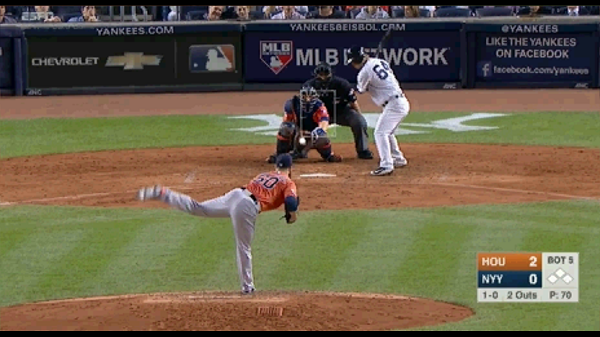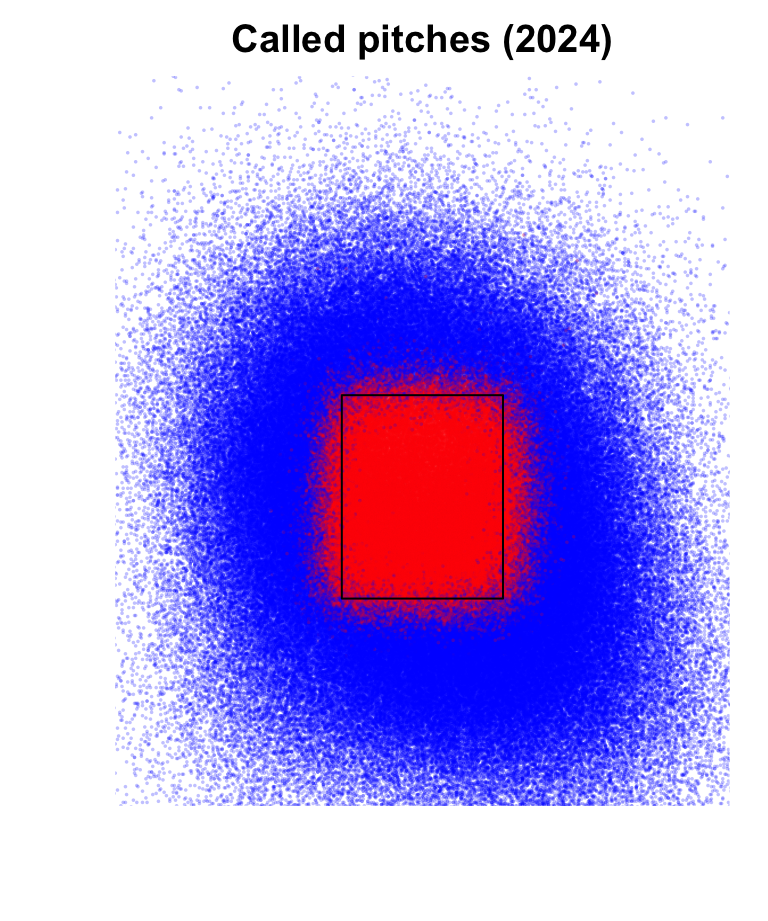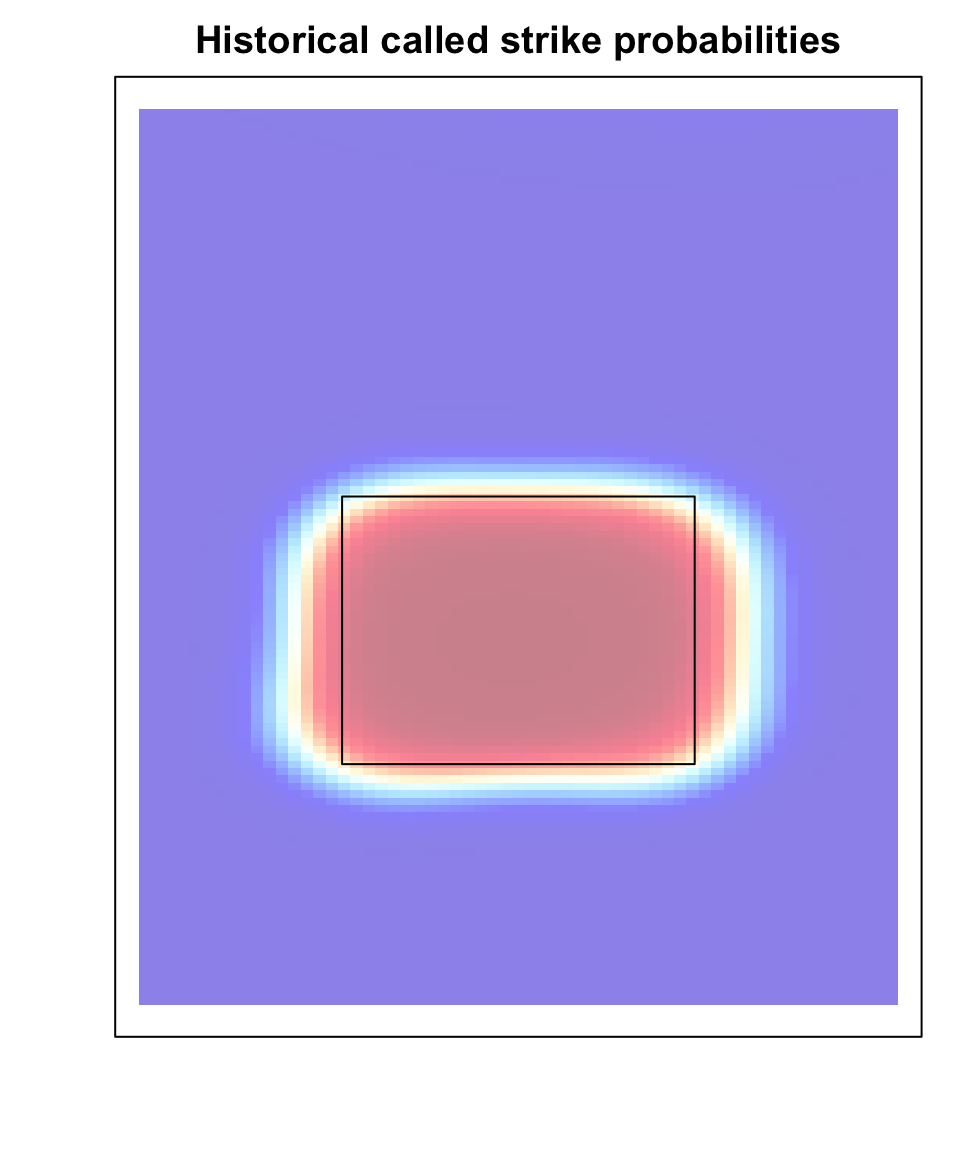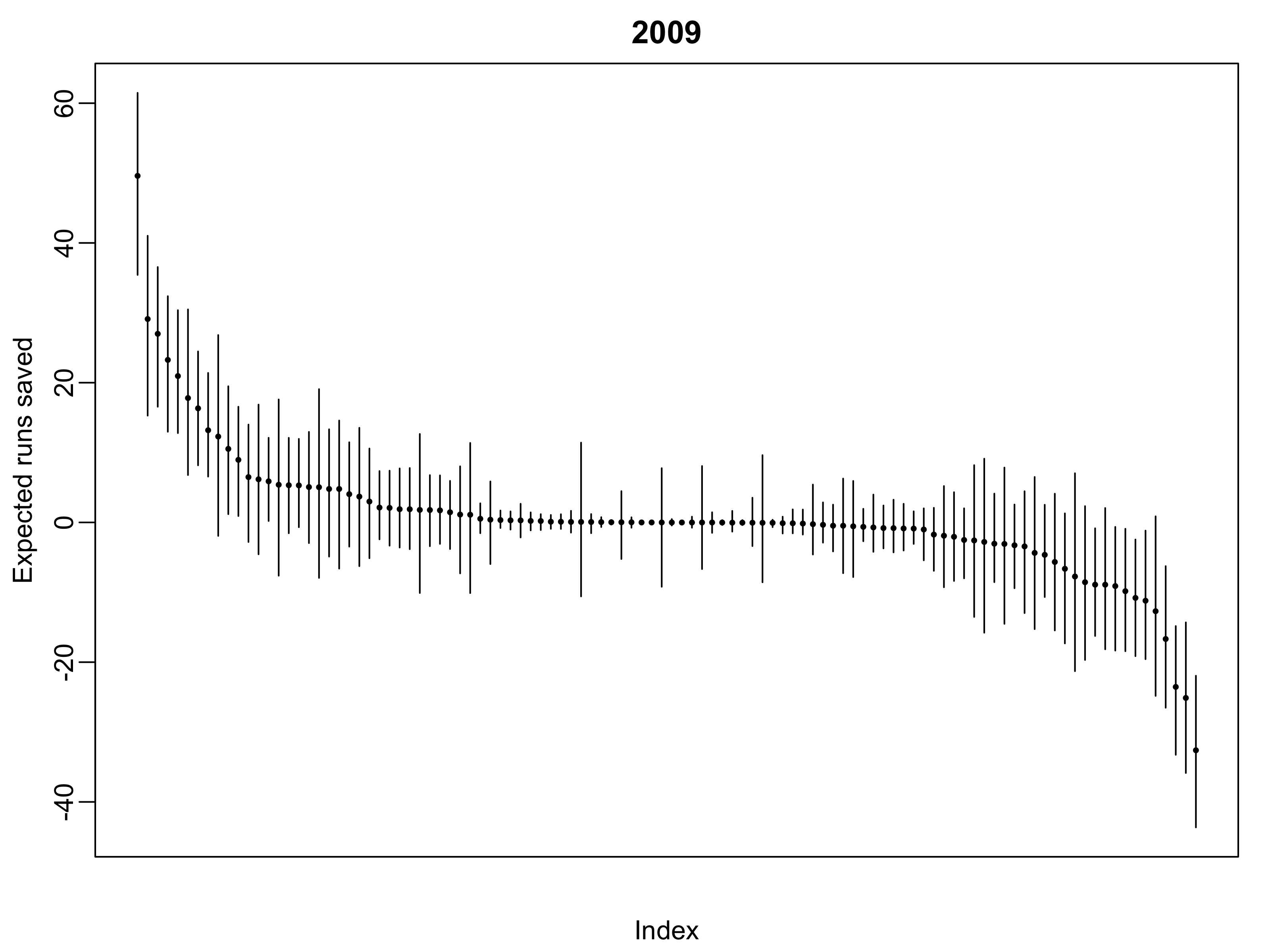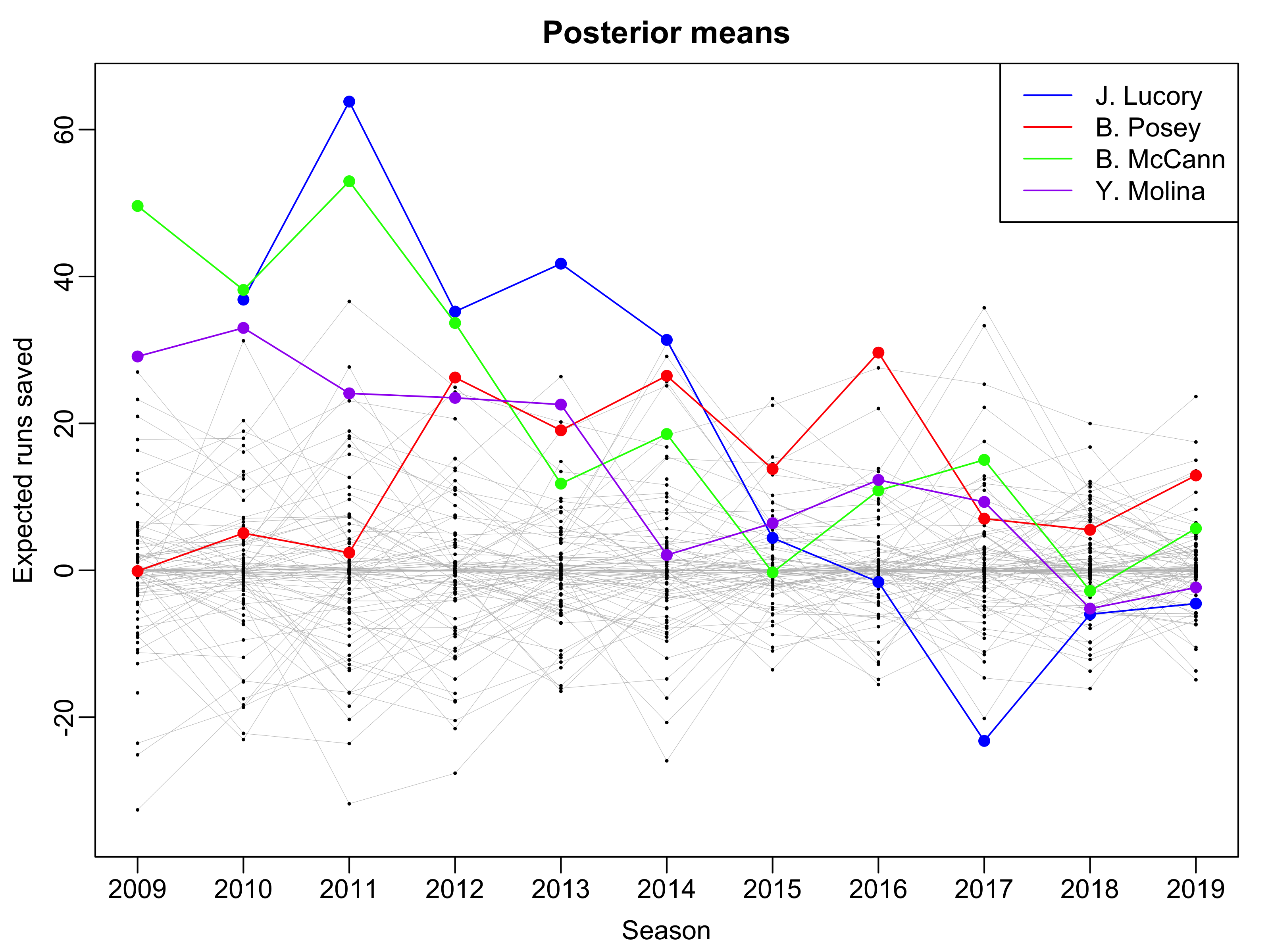ball blocked_ball bunt_foul_tip
231032 14717 15
called_strike foul foul_bunt
113912 126012 1208
foul_tip hit_by_pitch hit_into_play
7218 1979 121751
missed_bunt pitchout swinging_strike
196 52 73209
swinging_strike_blocked
3834 STAT 479 Lecture 11
Pitch Framing
Motivation
- Both pitches miss the strike zone and should, by rule, be called balls
- But pitch on the right was called a strike
- How much do catchers influence umpires’ calls?
Framing
- Ability of catcher to receive pitch so as to increase \(\mathbb{P}(\textrm{called strike})\)
- Ability to “steal a strike” / “turn balls into strikes”
- Studied by the sabermetrics community since 2008
- Lots of popular press attention b/w 2014 & 2016
Jonathan Lucroy Needs a Raise
According to Baseball Prospectus, Lucroy produced 121 stolen strikes last season and in the past five seasons clocks in at more than 1,000, the most in MLB. And if you believe the metrics, these stolen strikes have been worth about 18 wins during his five-year career – just shy of what Giancarlo Stanton’s entire output has added up to during the same time. Still, Lucroy’s discreetly prodigious output has been underestimated. By fans. By the media. By his own team. And certainly by the game’s salary structure. Even in today’s post-Moneyball world, pitch framing is viewed through a skeptical lens; a value-added talent, sure, but one for which teams are reluctant to pay. While Stanton cashed in with a 13-year, $325 million contract this offseason and Mike Trout begins the first year of his $144.5 million deal, Lucroy was actually more valuable last year. For that he earned $2 million; this year, he’ll make $3 million.
Put another way: The most impactful player in baseball today is the game’s 17th highest-paid catcher.
Overview
- Goal: estimate how many runs catcher saves his team
- Multilevel model to predict \(\mathbb{P}(\textrm{called strike})\)
- Random intercepts for batter, pitcher, catcher
- Fixed effect: baseline called strike prob. based on previous season
- “Runs Saved Above Replacement”
Value of a Called Strike
Elaborated Run Expectancy
- Lectures 6–8: run expectancy at the at-bat level
- Today: run expectancy at the pitch level
- \(\rho(\textrm{o}, \textrm{counts})\):
- Avg. runs scored following pitch in given count & game state
- 3 outs \(\times\) 12 counts
Identifying Taken Pitches I
description: pitch-level descriptor
Identifying Taken Pitches II
- Manually classify
descriptionvalues as called balls or strikes
swing_descriptions <-
c("bunt_foul_tip", "foul", "foul_bunt", "foul_tip",
"hit_into_play", "missed_bunt", "swinging_strike",
"swinging_strike_block")
taken2024 <- statcast2024 |>
dplyr::filter(!description %in% swing_descriptions) |>
dplyr::mutate(
Y = ifelse(description == "called_strike", 1, 0),
Count = paste(balls, strikes, sep = "-")) |>
dplyr::select(
Y, plate_x, plate_z, Count, Outs,
batter, pitcher, fielder_2,
stand, p_throws, RunsRemaining, sz_top, sz_bot) |>
dplyr::mutate(
Count = factor(Count),
batter = factor(batter),
pitcher = factor(pitcher),
fielder_2 = factor(fielder_2),
stand = factor(stand),
p_throws = factor(p_throws))Pitch-level Run Expectancy
- Only use taken pitches in each out-base runner-count state
er_balls: run expectancy following a called ball in given stateer_strikes: run expectancy following called strike in given state
er_balls <-
taken2024 |>
dplyr::filter(Y == 0) |>
dplyr::group_by(Count, Outs) |>
dplyr::summarise(er_ball = mean(RunsRemaining), .groups = 'drop')
er_strikes <-
taken2024 |>
dplyr::filter(Y == 1) |>
dplyr::group_by(Count, Outs) |>
dplyr::summarise(er_strike = mean(RunsRemaining), .groups = 'drop')
er_taken <-
er_balls |>
dplyr::left_join(y = er_strikes, by = c("Count", "Outs")) |>
dplyr::mutate(value = er_ball - er_strike)# A tibble: 10 × 5
Count Outs er_ball er_strike value
<fct> <int> <dbl> <dbl> <dbl>
1 0-0 0 0.731 0.605 0.126
2 0-0 1 0.547 0.425 0.122
3 0-0 2 0.283 0.193 0.0902
4 0-1 0 0.660 0.525 0.135
5 0-1 1 0.464 0.365 0.0990
6 0-1 2 0.234 0.166 0.0684
7 0-2 0 0.601 0.354 0.247
8 0-2 1 0.408 0.211 0.197
9 0-2 2 0.163 0 0.163
10 1-0 0 0.800 0.643 0.157 Most & Least Valuable Called Strikes
- For fielding team, a called strike
- In a 3-2 count w/ 0 outs saves 0.8 runs
- In a 0-1 count w/ 2 outs saves 0.07 runs
# A tibble: 4 × 5
Count Outs er_ball er_strike value
<fct> <int> <dbl> <dbl> <dbl>
1 3-2 0 1.12 0.321 0.800
2 3-2 1 0.815 0.203 0.612
3 0-0 2 0.283 0.193 0.0902
4 0-1 2 0.234 0.166 0.0684Multilevel Modeling
Pitch Location
plate_xandplate_zcoordinates of pitch as it cross front of home plateplate_xmeasured from catcher’s perspective (right-handed batters stand on the left)
High-Level Model
Level 1: Fixed effects of location (\(x\) and \(z\)) may be non-linear \[ \log \left( \frac{\mathbb{P}(Y_{i} = 1)}{\mathbb{P}(Y_{i} = 0)} \right) = B_{b[i]} + C_{c[i]} + P_{p[i]} + f(x_{i}, z_{i}) \]
Level 2: Random intercepts for Batter, Pither, Catcher \[ \begin{align} B_{i} &= \mu_{B} + u^{(B)}_{b[i]}; u^{(B)}_{b} \sim \mathcal{N}(0,\sigma^{2(B)}) \\ C_{i} &= \mu_{C} + u^{(C)}_{c[i]}; u^{(C)}_{c} \sim \mathcal{N}(0,\sigma^{2(C)}) \\ P_{i} &= \mu_{P} + u^{(P)}_{p[i]}; u^{(P)}_{p} \sim \mathcal{N}(0,\sigma^{2(P)}) \end{align} \]
- Idea #1: Assume \(f(x,z) = \beta_{X}x + \beta_{Z}z\)
- Problem: assumes \(\mathbb{P}(\textrm{called strike})\) is monotonic
Adjusting for Historical Tendencies
Instead of trying to pre-specify functional form of \(f(x,z)\) \[ \log \left( \frac{\mathbb{P}(Y_{i} = 1)}{\mathbb{P}(Y_{i} = 0)} \right) = B_{b[i]} + C_{c[i]} + P_{p[i]} + \beta_{p} \log\left(\frac{\hat{p}(x_{i}, z_{i})}{1 - \hat{p}(x_{i}, z_{i})}\right) \]
\(\hat{p}(x,z)\): baseline called strike prob. estimated from 2023 season
Historical GAM
- Filter out pitches too far away from strike zone
plate_xoutside [-1.5, 1.5]plate_zoutside [1,6]
Historical Called Strike Probability
Appending Baseline
- Historical GAM trained on 2023 data
- Use it to make predictions on all 2024 taken pitches
Fitting our Model
library(lme4)
multilevel_fit <-
glmer(formula = Y ~ 1 + (1 | fielder_2) + (1 | batter) + (1 | pitcher) + baseline,
family = binomial(link = "logit"),
data = taken2024)
summary(multilevel_fit)Generalized linear mixed model fit by maximum likelihood (Laplace
Approximation) [glmerMod]
Family: binomial ( logit )
Formula: Y ~ 1 + (1 | fielder_2) + (1 | batter) + (1 | pitcher) + baseline
Data: taken2024
AIC BIC logLik -2*log(L) df.resid
111223.6 111276.3 -55606.8 111213.6 274780
Scaled residuals:
Min 1Q Median 3Q Max
-69.844 -0.135 -0.014 0.116 161.727
Random effects:
Groups Name Variance Std.Dev.
pitcher (Intercept) 0.05122 0.2263
batter (Intercept) 0.02629 0.1621
fielder_2 (Intercept) 0.04360 0.2088
Number of obs: 274785, groups: pitcher, 851; batter, 649; fielder_2, 100
Fixed effects:
Estimate Std. Error z value Pr(>|z|)
(Intercept) 0.084101 0.027122 3.101 0.00193 **
baseline 1.027338 0.004563 225.126 < 2e-16 ***
---
Signif. codes: 0 '***' 0.001 '**' 0.01 '*' 0.05 '.' 0.1 ' ' 1
Correlation of Fixed Effects:
(Intr)
baseline 0.023 Extracting \(u^{(C)}_{c}\)
- Model: \(C_{c} = \mu_{C} + u^{(C)}_{c}\) where \(u^{(C)}_{c} \sim \mathcal{N}(0,\sigma^{2}_{c})\)
- Reminder: cannot directly estimate catcher-specific intercepts \(C_{c}\) or global average \(\mu_{C}\)
- We can extract deviations \(u^{(C)}_{c}\) using
ranef()
Runs Saved Above Replacement
Defining Replacement Level
- Non-replacement: top \(30 \times 2\) catchers sorted by number of pitches caught
- \(\overline{u}^{(C)}_{R}\): average \(u^{(C)}_{c}\) among all replacement-level catchers
catcher_counts <-
statcast2024 |>
dplyr::group_by(fielder_2) |>
dplyr::summarise(count = dplyr::n()) |>
dplyr::arrange(dplyr::desc(count))
catcher_threshold <-
catcher_counts |>
dplyr::slice(60) |>
dplyr::pull(count)
catcher_u <-
catcher_u |>
dplyr::left_join(y = catcher_counts, by = "fielder_2")
repl_u <-
catcher_u |>
dplyr::filter(count < catcher_threshold) |>
dplyr::pull(catcher_u) |>
mean()Counterfactual Predictions
- For every taken pitch, use model to predict
- Called strike prob. with original catcher
- Called strike prob. with a replacement-level catcher
- Original log-odds:
\[ \mu_{C} + u_{c[i]}^{(C)} + B_{b[i]} + P_{p[i]} + \hat{\beta}_{p} \times \log\left(\frac{\hat{p}(x_{i}, z_{i})}{1 - \hat{p}(x_{i}, z_{i})} \right) \]
- Counter-factual log-odds:
\[ \mu_{C} + \overline{u}_{R}^{(C)} + B_{b[i]} + P_{p[i]} + \hat{\beta}_{p} \times \log\left(\frac{\hat{p}(x_{i}, z_{i})}{1 - \hat{p}(x_{i}, z_{i})} \right) \]
Computing Counterfactual Predictions
- Subtract original \(u^{(C)}_{c}\) and add \(\overline{u}^{(C)}_{R}\) to log-odds
Computing RSAR
- Weight change in called strike prob. by value of called strike
- Sum
rsarvalue across whole season
# A tibble: 10 × 2
Name rsar
<chr> <dbl>
1 Patrick Bailey 29.9
2 Cal Raleigh 19.8
3 Austin Wells 17.9
4 Alejandro Kirk 17.2
5 Jake Rogers 16.8
6 Christian Vazquez 15.1
7 Jose Trevino 14.6
8 Francisco Alvarez 13.4
9 Bo Naylor 11.5
10 Yasmani Grandal 11.0Uncertainty Quantification
- Top framers appear to save nearly 30 runs over replacement
- Translates to about 3 wins
- Exercise: use the bootstrap to quantify uncertainty
- Create several bootstrap re-samples of 2024 taken pitches
- Must re-fit the multilevel model and compute GSAR
- Use the original replacement-level
- Quantifying uncertainty: critical to determining monetary value of framing
My Own Research
- I’ve studied framing since 2015
- Initial paper: Bayesian models to “borrow strength” across umpires
- Conclusion: lots of uncertainty in framing effects
- More recently: use Bayesian Additive Regression Trees (BART) to model \(\mathbb{P}(\textrm{strike})\)
- Faster & more flexible: (2 hours on a desktop vs 50 hours on a cluster)
- Better predictions: mis-classification of 7% vs 10%
- Similar conclusions: possibly large effect but lots of uncertainty
Framing Effectsin 2009
Framing Over Time
Announcements
- Projects are due tomorrow at noon
- If you need an extension, email me
- Peer review assignments will be made on Canvas by Sunday night
- Peer review due on Sunday 10/18
- Next week: new unit on ranking & simulation
- Lectures 12 & 13: hockey power rankings & the NCAA D1 National Championship
- Lecture 14 & 15: Markov chain simulations
- Lecture 16 & 17: Mock drafts & other simulations
- Project 2 Information will be posted by Sunday evening

